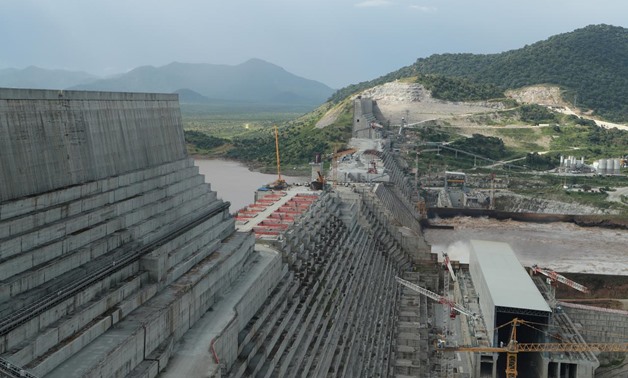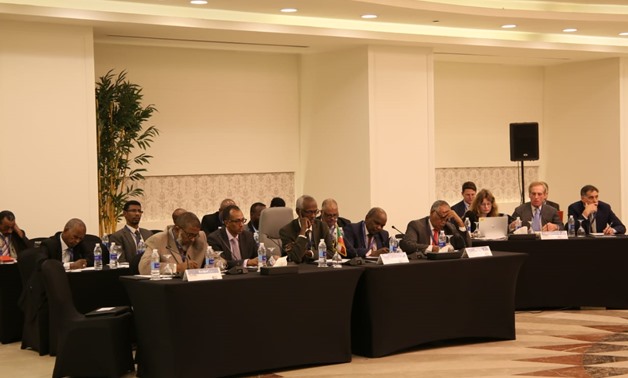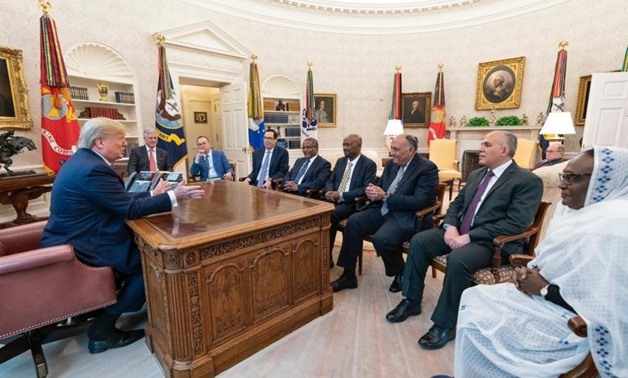Six Meetings chaired by H.E., Mr. Mnuchin the secretary of the treasury Department in Washington, USA. Additional four rotational meetings were held in the three countries (Egypt, Ethiopia, and Sudan) in the presence of representative observers from the USA, and the World Bank. Ethiopia attended all meetings, except the last one, with full participation in the discussions and conclusions.
Despite the agreement of all parties (including Ethiopia), about the date of the last meeting, and the meeting will be assigned, for the final touches and minor modifications, if any, Ethiopia declined in the last moment to attend.
These meetings had one main scope and objective unanimously agreed upon, “Establishment Of the guidelines and rules governing the filling and operation of Grand Ethiopian Renaissance Dam in an adaptive and cooperative manner”.In order to achieve the scope and main objective, the two main principles, “Cooperative, and Adaptive”, were agreed upon.
Before start reflecting on the meetings, some facts have to be presented. The facts will help to depict the differences between the two title words “Cooperation and Antagonism”, which will be frequently repeated in the article.
The green water in Ethiopia is more than 850 mm/year, against 10mm/year for Egypt. The renewable groundwater share per capita for Ethiopia is 400m3/capita/year (as presented in Ethiopia water and Energy week), while for Egypt is limited to 2.3 m3/capita/year.
The water resources share for Egypt is 570 m3/capita/year, compared with capita share of Ethiopia about 1227 m3/capita/year (up to 2017 records). Ethiopia has 12 Basins including the Blue Nile, where GERD is under construction.
The Nile water dependency ratio of Egypt is 97%, and 0% for Ethiopia. Egypt has the highest irrigation efficiency, more than 85%, among all Nile basin countries. Egypt is recycling the drainage water to reach such high efficiency, and fill the gap between the supply and demand. The safeguard of Egyptian water resources is High Aswan Dam (HAD).
The comparison between the above numbers of the two countries having nearly the same populations (100 million), in case the (Cooperation) mode rather than the (Antagonism) mode is adopted, may emphasis on which side the term equitable water utilization will support. HAD was constructed and operated more than 5 decades, where 100 million Egyptians relying and living on it.
Being the most Down Stream country in the Nile system, HAD was constructed to protect Egypt from flooding and drought cycles of the Nile, without causing any harm to any other riparian country.
GERD is under construction with no operation yet, on a country wealthy of water resources. As a newly introduced dam to the Eastern Nile system, GERD has impacts on the two DS countries, Egypt and Sudan.

GERD as announced has a sole purpose of power generation, and it aims non-consumptive utilizing the water of the Blue Nile for power generation. The comparison is between two dams, HAD has no impact on the riparian countries, while GERD has impacts on hundreds of Million in the DS countries. HAD constructed and operated more than 50 years ago, while GERD is under construction and no operational yet.
From the technical point of view, the only way to study the impact of a newly constructed DAM, such as GERD, on a downstream system of multi reservoirs, is to use the technique of “simulation of multi reservoirs operation”.
Over the last decade, many studies and researches were published, addressing the impacts of GERD on the DS, no single study excluded HAD from the simulation. In 2011, Egypt agreed to form an International Panel of Experts (IPOE), recognizing that GERD is under construction, and conditioned that Ethiopia will provide detailed studies proving that GERD impacts are insignificant.
The IPOE report issued in 2013 indicated that the studies are incomplete, and neglected many major issues; the reader may refer to the published report available on the internet. Despite the studies were incomplete, the Environmental Impacts Assessment (EIA) study presented by Ethiopia indicated a sever impacts on Egypt. IPOE issued a draft scope of work for additional studies.
This scope addressed very clearly the importance of including HAD in the simulation, the word HAD was listed in almost every single page of the report. The establishment of the Tripartite National Committee (TNC) in 2014 was based on executing the IPOE recommendations by hiring a consultant to carry out the studies.
The failure of reaching any conclusion was the Ethiopian rejection of including HAD in the simulation(ANTAGONISM).The Egyptian acceptance of GERD being under construction without prior notification and incomplete studies is (Cooperation).
The Ethiopian rejection, against the international norm, of including HAD (operating more than 5 decades) in the simulation (ANTAGONISM). The same reason was the cause of the failure of the National Independent Scientific Research Group (NISRG), formed to reach an agreement about filling and operation of GERD. NISRG had four meetings, in the third round, the Ethiopian technical team, was convinced to include the levels (shutdown, and critical) of all dams including HAD, as criteria of filling and operation.

The fourth meeting was a complete downfall, where Ethiopia, again, insisted to remove any levels related to HAD, or even mentioning the word HAD, from the simulation and agreement (ANTAGONISM).
The design of the reservoir size, dimensions of the dam elements, are based on the historical flow records prior to the construction of the dam. Such flow records are called the river natural flow, including the existing structures (Cooperation).
In order to study the impacts on HAD, a comparison between the flow reaching HAD from all upstream tributaries, including the Blue Nile, before GERD construction, and the same after the construction. This has been met by Ethiopian rejection (ANTAGONISM). Based on that stand, Egypt accepted to use the release from GERD as the main criteria, without detailing the impacts on HAD (Cooperation).
FIRST FILLING
The initial debate about first filling was about fixing number of years of filling, which is not adaptive to the high variability of the natural flow as discussed earlier. Eventually, the Ethiopian proposal of filling in stages was accepted (Cooperation), where filling could be accelerated or decelerated as per the hydrological conditions.
The challenge faced the Egyptian technical team is how to evaluate the impacts without including HAD levels. Finally, a minimum release value from GERD and number of years have been introduced and adopted (Cooperation). A peculiar and contradicting stand of the Ethiopian team during the course of negotiation was clear to all parties.
Discussing the filling stages, the Ethiopian team was fully recognizing HAD as currently full of water, requesting unconditional filling of stages. The Egyptian team stated the fact that the filling may be delayed, and will take several years where the storage in HAD may be depleted, and requesting for (Cooperation) from GERD. The Ethiopian reply, we are not recognizing HAD (ANTAGONISM).
Three conditions/definitions during filling was agreed upon and adopted, Drought, Prolong Drought, and Prolong Period of Dry Years. The three terms are based on the minimum release from GERD for number of years.
The minimum release from GERD was based on the probability of occurrence, obtained from the historical flow records at GERD site. For wet periods, GERD may complete first filling in 4-5 years, and start generating 80% of targeted power after the second year. For average flow periods, GERD may complete first filling in 6-7 years, and start generating 80% of targeted power after the second year.
For dry periods,GERD may complete first filling more than 10 years, based on the severity of the drought, and start generating 80% of targeted power after the second year. The dry period probability does not exceed 9%, indicating a probability of more than 91% of achieving the Ethiopian plan of filling (Cooperation). Egypt accepted the risk of dramatic depletion of HAD live storage, and accepting the risk of water shortage, and increase of the food gap during the filling of GERD (Cooperation).
This article addressed some reflections on the first filling of GERD, which can be summarized as follows:
• Egyptian recognition that GERD is under construction, without the Ethiopian prior notification, and incomplete studies of the impacts on the downstream (Cooperation), Against Ethiopian complete unrecognition of a DS reservoir (HAD) operated for more than 50 years, and hundreds of million living on HAD (ANTAGONISM)
• Egyptian acceptance of giving Ethiopia a high probability exceeding 90% to fill the Dam in the shortest possible period(Cooperation)
• Egyptian acceptance, during the most severe drought periods, of preserving a minimum level higher than the level produce at least 80% of GERD electricity(Cooperation)
• Egyptian acceptance, during the most severedrought periods, that GERD not releasing the volume belowcertain level (Cooperation).
• Egyptian acceptance of depleting about high percentage of the life storage volume of HAD with a probability about 10%(Cooperation)
• Egyptian acceptance of bearing the risk of the definite shortage in water which will take place during the filling and operation of GERD(Cooperation)
• Egyptian acceptance of losing the majority of HAD power generation on the expense of GERD generating at least 80% of its targeted power generation (Cooperation).
• Egypt acceptance that future development US GERD is not foreclosed, conditioned to be in accordance with the International law (Cooperation)
• Egypt acceptance of the US and WB as a middle ground (Cooperation)
• Ethiopian Rolling Back from signing the agreement, which is full of Egyptian (Cooperation), after exhausting long track of negotiation in Washington and not accepting the middle ground proposal of the US and WB (ANTAGONISM).
Important questions need to be answered: Why Ethiopia could not finish the long marathon of Washington meetings? And Why Ethiopia claims that US and the WB are impartial?. The answer may be summarized in two words Unilateralism, and Antagonism.
Written by Dr. Alaa ELZawahry, Prof. of Hydraulics, Faculty of Engineering, Cairo University TNC, NISRG and Washington Negotiations Member



Comments
Leave a Comment